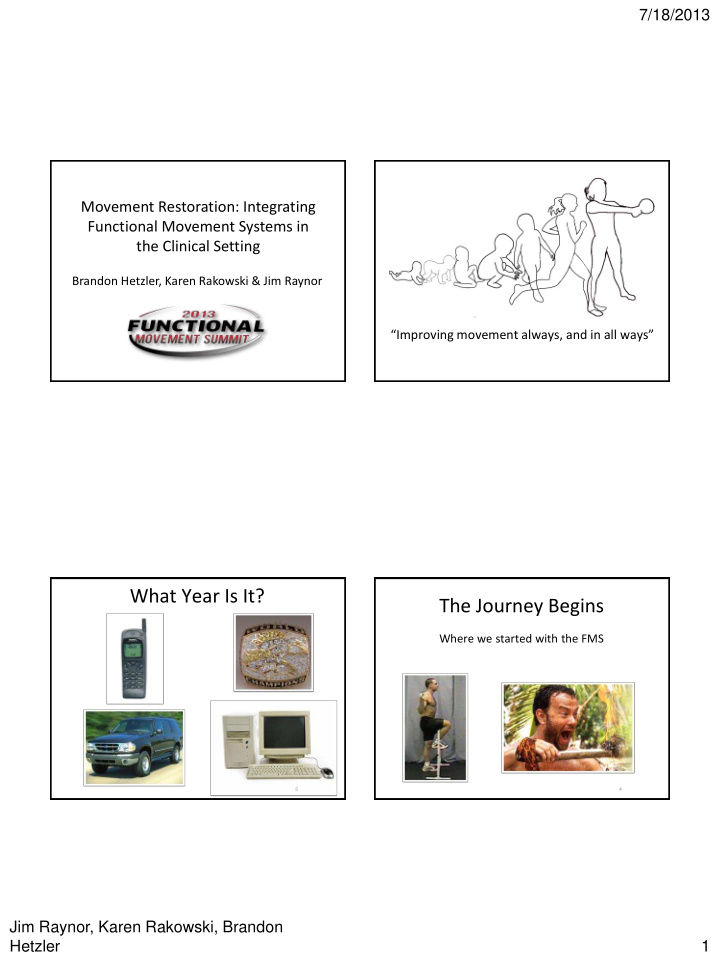



7/18/2013 Movement Restoration: Integrating Functional Movement Systems in the Clinical Setting Brandon Hetzler, Karen Rakowski & Jim Raynor “Improving movement always, and in all ways” What Year Is It? The Journey Begins Where we started with the FMS 3 4 Jim Raynor, Karen Rakowski, Brandon Hetzler 1
7/18/2013 The Journey Got Crowded The Journey Got Longer • Sports Medicine • Outreach Program 1998-2003 WE FAILED Departments Consolidated • Undergraduate athletic – In application • Performance/Injury training education – In research Prevention • Graduate athletic – But, we knew we were on to something • Sports Injury Therapy training education • Medical Fitness Model 5 6 Not Satisfied The Journey Got Complicated • FMS • Introduced to kettlebells We want a protocol • FMS Level 2 • SFMA Why? • Dabbled into the • SFMA Level 2 “ground up” progression 7 8 Jim Raynor, Karen Rakowski, Brandon Hetzler 2
7/18/2013 Birth of Movement Restoration 9 Problem One Jim Raynor, Karen Rakowski, Brandon Hetzler 3
7/18/2013 Mistakes Anyone? • Using FMS for “diagnosis” • Using the FMS & SFMA together • Lack of attention to detail administering the FMS/SFMA • Not trusting the tool • Being too detailed with • “I don’t have time to treat interpretation everyone’s cervical dysfunction!” • Making it the _MS • Trying to get all the DN’s to FN’s • Treating the score • Screening & assessing movement • Trying to fix a squat with a squat, a quality but failing to apply the same rules to the interventions... roll with a roll... The Missing Piece Jim Raynor, Karen Rakowski, Brandon Hetzler 4
7/18/2013 “Standard Operating Procedure” The "Corrective Exercise" Paradox “Exercise” Movement Assessment • What is corrective exercise? • "Corrective exercise is like vegetables and lifting is steak. Steak makes you strong, vegetables make you healthy." Pavel What do you do? Movement Assessment SOP • 19 year old Female basketball player A • Goal is to get stronger and B faster for basketball • No pertinent medical history or medical conditions • Point A / Point B Group activity • 4-5 people • Come up with 2 exercises to address the previous slide Jim Raynor, Karen Rakowski, Brandon Hetzler 5
7/18/2013 Neurodevelopmental Sequence “Exercise” SOP (NDS) "Simplicity is the ultimate sophistication." Da Vinci Squat Breathing “Stability and Motor Control are posture specific.” -Gray Cook Crawling Rolling Single Leg "Stuff" Missing the point Jim Raynor, Karen Rakowski, Brandon Hetzler 6
7/18/2013 Examples How do we apply this approach • 21 year old college female across the "subject" spectrum? • All 2's, no asymmetries 1 • Movement develops in a sequential fashion • Wants to improve her game • Strength develops in a sequential fashion (What “strength” pattern develops first??) • 17 year old male 6 months into his rehab • Movement progression stays the same, movement “intensity” varies for ACL reconstruction 2 The Rehab/Training Continuum • All 2's, no asymmetries, but doesn't feel "right" • Wants to get back to high school sports • 56 year old female housewife Moving • All 2's, no asymmetries "Training" 3 • Wants to fit into a dress for her son’s upcoming Rehab wedding and "firm up" Jim Raynor, Karen Rakowski, Brandon Hetzler 7
7/18/2013 Our Solution? An Exercise SOP A B SPORTS MEDICINE & ATHLETIC TRAINING PROGRAM karen.rakowski@mercy.net simplykettlebells@gmail.com Jim Raynor, Karen Rakowski, Brandon Hetzler 8
Recommend
More recommend